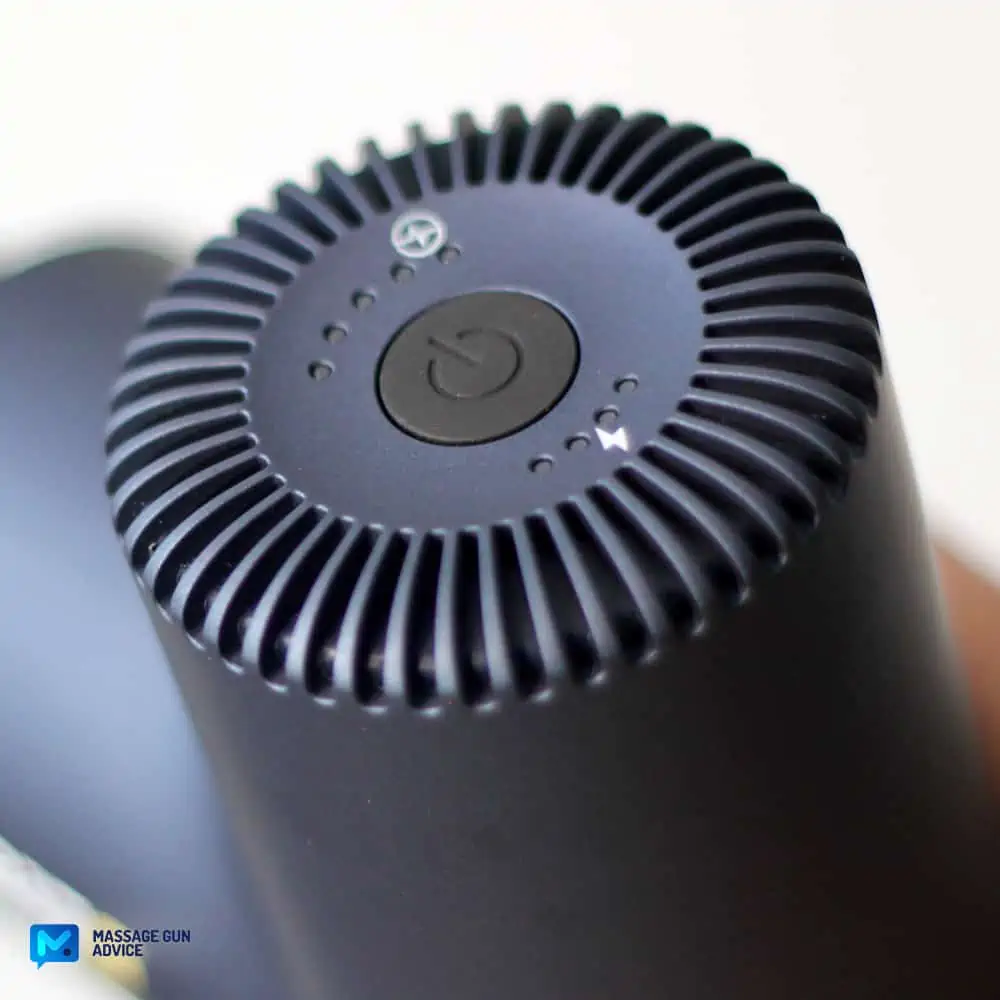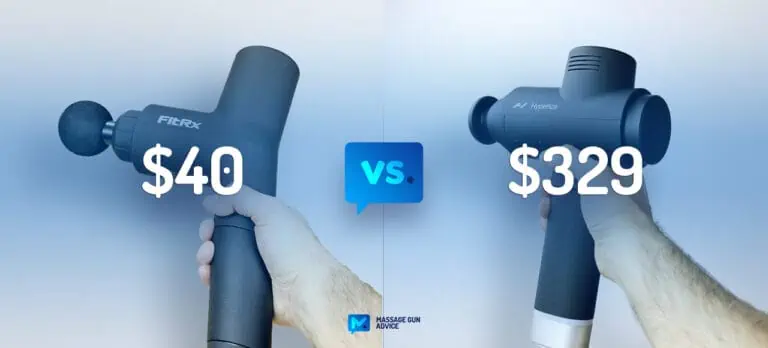What to Know: We independently review products we recommend. If you click on links we provide, we may earn a commission. Learn more.
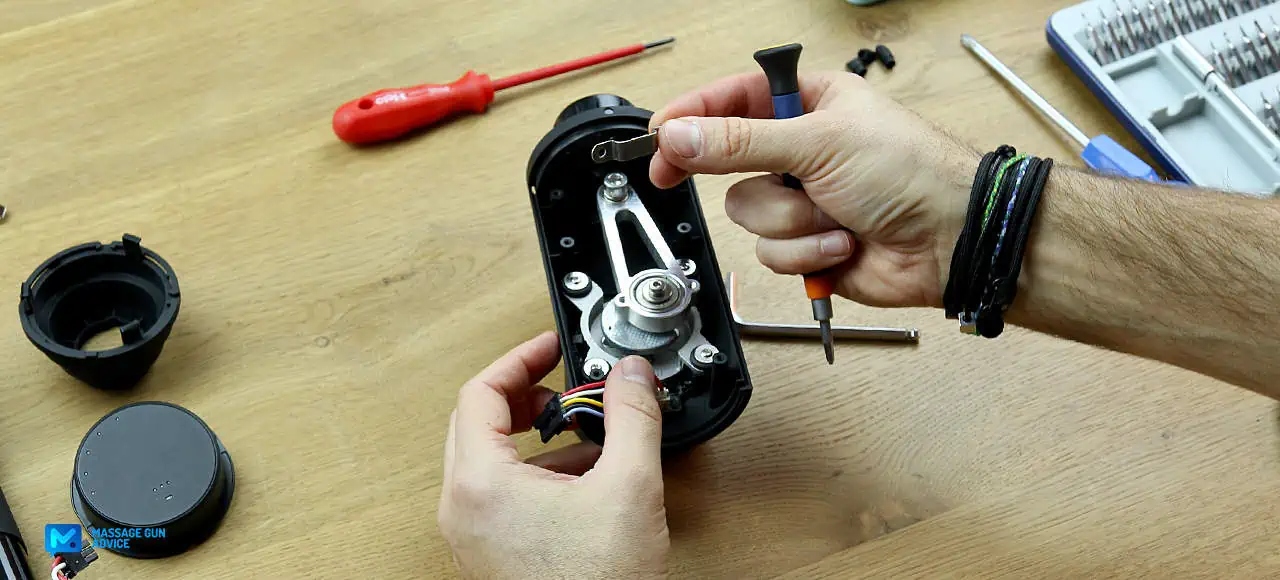
What’s Inside a Massage Gun: How It Operates, Mechanics, and Technical Basics
What’s inside a massage gun? How is a massage gun constructed? These are questions that often go unanswered, but that’s where we come in.
Armed with knowledge gained from dismantling two massage guns and closely examining their inner workings, I’ve crafted what I believe to be useful information about what makes these trendy gadgets tick.
Take a front-row seat with the experts and learn!
- Basic Definition
-
Massage Gun Construction Elements – Know Your Device Inside Out!
- Motor – The Driving Force of the Massage Gun
- Percussive Mechanism – The Engine of Relief
- Massage Gun Head – The Personal Touch of Relief
- Battery – The Essential Power Source of Massage Guns
- Control Panel – Navigating Massage Gun Settings
- Housing – The Intersection of Style, Comfort, and Durability in Massage Guns
- Conclusion
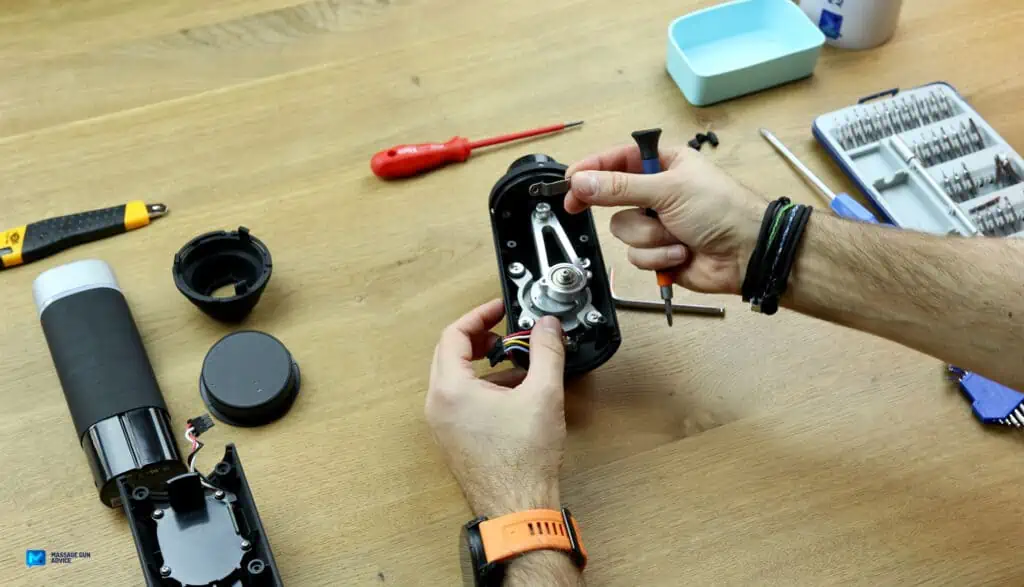
Basic Definition
Massage guns work by using a motor to create rapid percussive movements, delivering targeted pressure to muscles for relief and relaxation.
Sounds pretty simple, right? Don’t count your guessing stars yet, there’s more to it. Let’s unpack a few things.
Massage Gun Construction Elements – Know Your Device Inside Out!
So, these are the elements without which there is no massage gun. We will discuss each of them in more detail later, but for now:
- Motor: You can call it the heartbeat of a massage gun, and literally so. It generates a rotating force that translates into the back-and-forth movement of the massage gun head. The motor’s quality is crucial as it influences the massage gun’s overall performance, impacting factors like speed and power.
- Percussive Mechanism: This mechanism is connected to the motor. It converts the motor’s rotational movement into a percussive, back-and-forth motion. This action is responsible for the rapid pressure bursts that penetrate muscle tissue, providing relief and relaxation.
- Massage Heads: These are various attachments that come with the massage gun, each designed for different uses. The material and shape of each head determine the kind of massage experience you get, from soft and gentle to deep and intense.
- Battery: The majority of massage guns are wireless, powered by rechargeable batteries, typically lithium-ion. This feature adds to their convenience, making them easy to use and transport without the need for power cords. Note that there are also some models with cords, which we cover here.
- Control Panel: The control panel is your gateway to customizing your massage experience. It typically includes buttons for powering the device on or off and adjusting speed settings. High-end models may offer more advanced controls, allowing for greater customization of your massage session.
- Housing: The external casing of the massage gun isn’t just about aesthetics; it’s crucial for ergonomics and durability. A well-designed housing makes the device easy to hold and maneuver, while also protecting the internal components from damage. It’s a blend of functional design and practical protection.
Below, the inner of the Each component you see will be discussed in detail shortly.
This diagram illustrates the inner workings of a massage gun, specifically the Ekrin B37, which we have tested extensively.. It highlights each essential part, from the brushless motor to the high-density EVA head. All these components, plus the battery, work in harmony to deliver muscle relief.
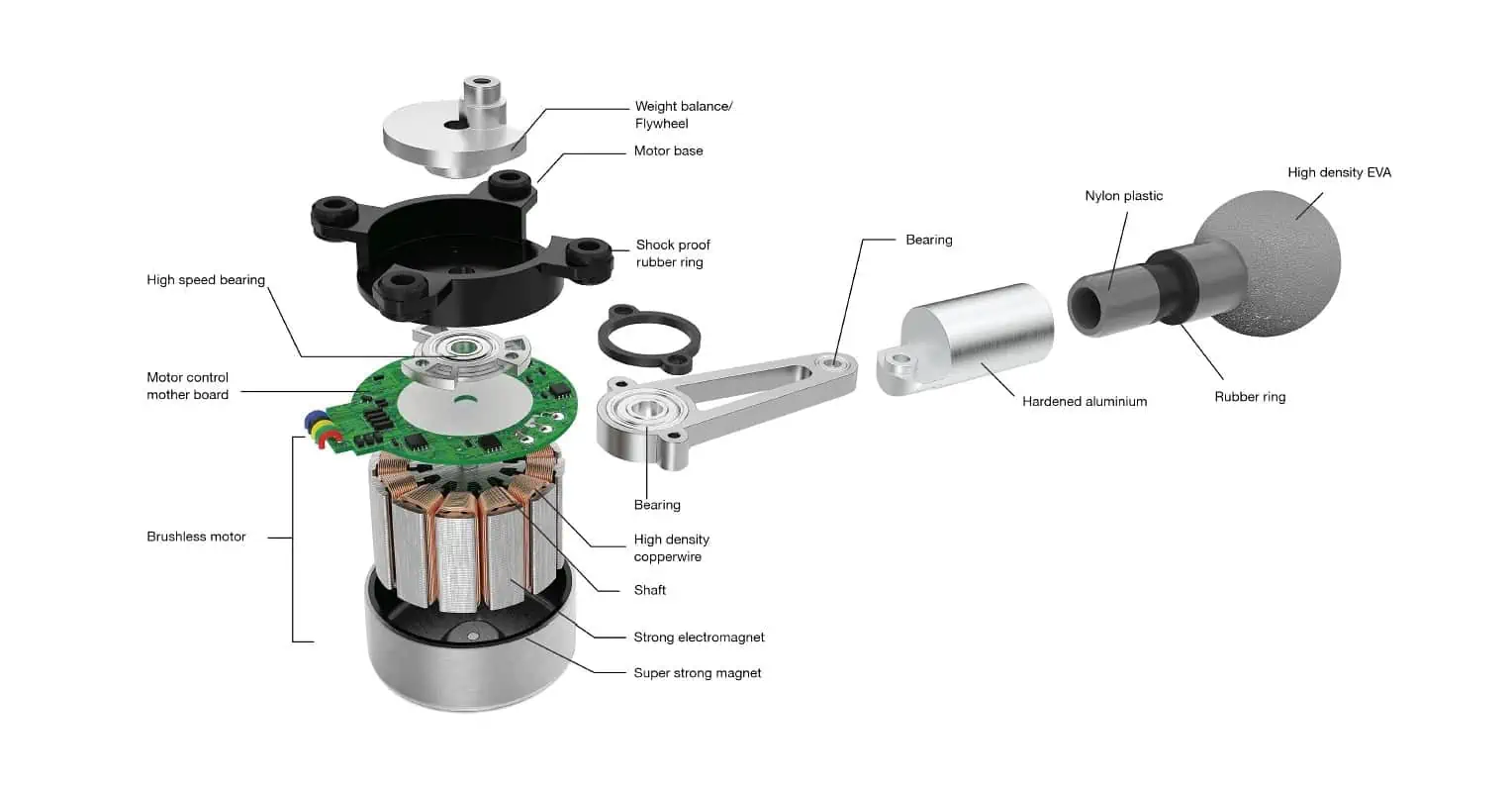
And here is what we found inside the Hypervolt 2 Pro when unscrewed. Pretty much exactly all the parts from the illustration above.
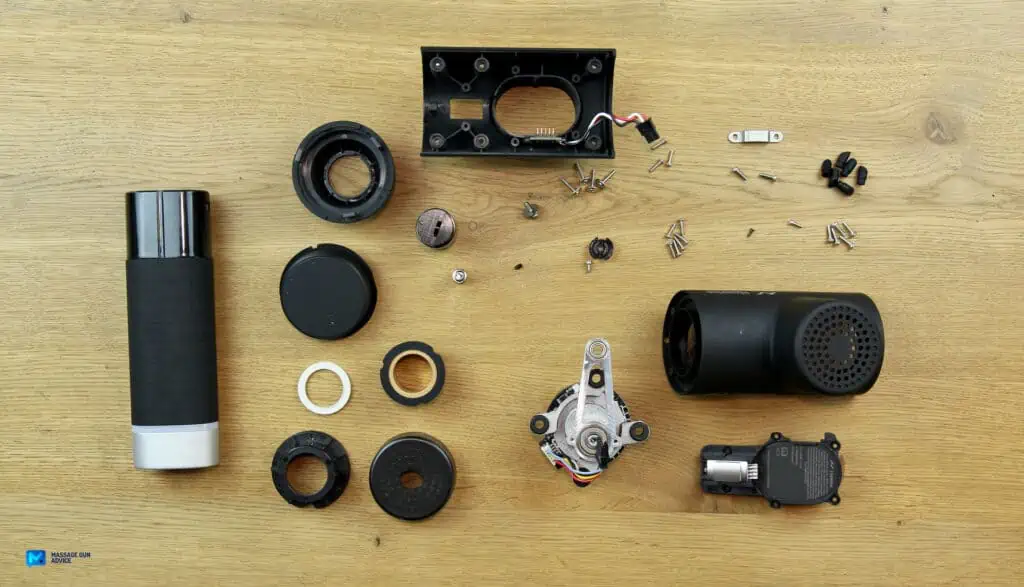
Now let’s break all the key components down a bit more…
Motor – The Driving Force of the Massage Gun
The motor is the heartbeat of any massage gun, a pivotal component that defines the overall performance and user experience. It’s the engine room where power meets precision.
A well-crafted motor not only determines the effectiveness of the massage by providing the right amount of force but also influences other key aspects:
- Quiet Operation: Advanced motors are engineered to be as unobtrusive as possible, allowing for a powerful massage without the disruptive buzz. See more on quietest massage guns here.
- Efficient Heat Management: Top-notch motors are designed to manage heat effectively, preventing overheating. This is crucial for both the safety of the user and the longevity of the device.
- Longevity and Durability: The motor’s resilience determines how long the massage gun will serve you reliably. Manufacturers are continuously innovating to produce motors that can withstand prolonged use, ensuring your investment lasts.
- Balance Between Power and Noise: As technology evolves, so does the capability of these motors. The latest designs are not just about raw power; they’re about delivering that power in a smooth, quiet, and sustainable manner.
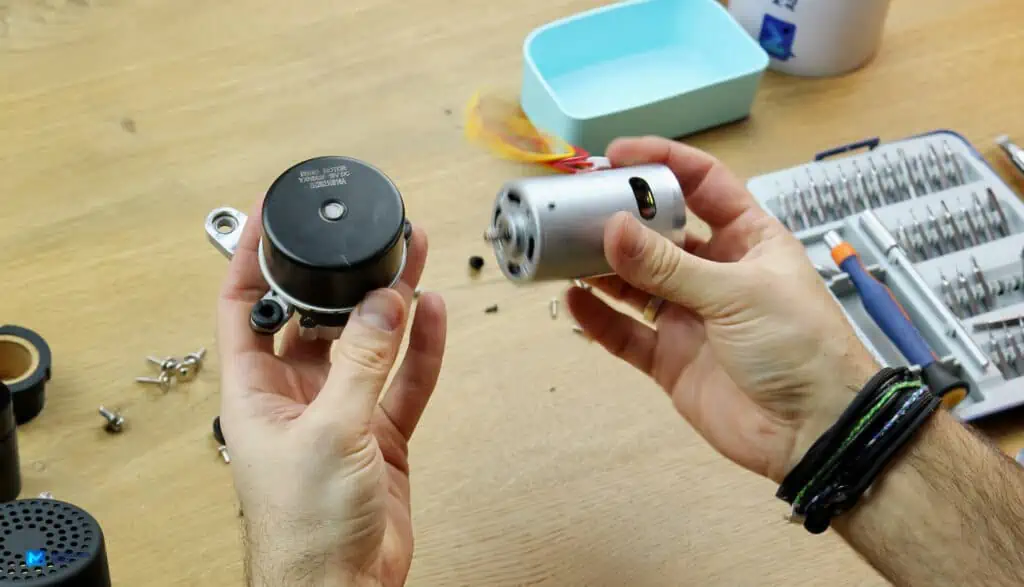
Types of Motors
There are two types of motors in massage guns:
Brushless DC Motors (BLDC)
These motors are the hallmark of higher-end massage guns. Brushless DC motors1 stand out for several reasons:
- Efficiency: They are more energy-efficient, meaning they can deliver more power while using less battery.
- Longevity: BLDC motors tend to have a longer lifespan. This is due to the lack of brushes, which are often the first component to wear out in a motor.
- Lower Maintenance: Without brushes, these motors require less maintenance and are less prone to wear and tear.
- Quieter Operation: They generally operate more quietly, a significant advantage for a device used in close proximity to the body.
Brands Using BLDC Motors: Renowned brands like Therabody, Hypervolt, Ekrin Athletics, Opove, and Achedaway opt for brushless DC motors in their designs, indicating a commitment to quality.
Brushed Motors
Found in some less expensive models, brushed motors are more traditional but come with certain drawbacks:
- Less Efficient: They are not as efficient as their brushless counterparts, often requiring more power for the same output.
- Shorter Lifespan: The brushes in these motors are subject to wear and tear, leading to a shorter overall lifespan of the motor.
- Higher Maintenance: Due to the presence of brushes, these motors typically need more maintenance.
Usage: Brushed motors are commonly seen in more affordable models, including some budget-friendly options manufactured in China, as well as in older massage gun designs.
Power – The Essence of Motor Performance in Massage Guns
Understanding the power of a massage gun’s motor involves looking at several key metrics, each revealing a different facet of the motor’s capabilities:
- Voltage (V): Think of voltage as the ‘push’ that drives electrical energy through the motor. It’s a bit like water pressure in a hose; the higher the voltage, the stronger the current that the motor can handle. In massage guns, especially those that are battery-operated, voltage is a critical factor. It indicates how much power the battery is capable of delivering to the motor, influencing the overall power output of the device.
- Wattage (W): Wattage represents the actual power consumption or output of the motor. It’s calculated by multiplying the voltage by the current (in Amps, A). This figure gives you a direct sense of the motor’s energy usage and its capacity to perform work. A higher wattage means the motor can deliver more power, translating into more robust massage capabilities.
- Stall Force (lbs): This parameter is crucial for those seeking deep tissue massages. Stall force is the amount of pressure you can apply to the massage head before the motor stops or “stalls.” A higher stall force indicates a more robust motor that won’t easily give out under heavy pressure. This is particularly important for deep tissue work, where firm pressure is applied. Generally, motors with higher wattages offer greater stall forces, enabling them to sustain more intense use.
- Revolutions Per Minute (RPM)2: RPM measures the speed of the motor and, by extension, the massage head. It indicates the number of oscillations the head makes in a minute. Higher RPMs can provide a more intense and rapid massage, targeting muscles quickly and effectively. Conversely, lower RPMs are suited for gentler, more relaxing massages. This versatility allows users to tailor their massage experience to their specific needs.
Summary
Voltage and Wattage define the motor’s power, Stall Force gauges its ability for deep pressure, and RPM sets the massage’s speed and intensity.
Percussive Mechanism – The Engine of Relief
The percussive mechanism in a massage gun, often termed as Eccentric Rotating Mass (ERM) or a cam mechanism, is the ingenious system that turns rotation into therapeutic pulsation.
The size of the eccentric weight inside a massage gun controls how far the head moves back and forth—this is called amplitude. The larger the offset, the deeper the massage, but at the expense of speed, as the head has a greater distance to travel in the same amount of time.
Here’s the breakdown:
- Motor’s Rotation: It all starts with the motor. Its job is to generate rotational motion, converting electrical energy into the mechanical energy that powers the device.
- Eccentric Rotating Mass (ERM)3: Attached to the motor’s shaft is an eccentric weight, imbalanced by design. As it spins, this asymmetry creates a wobble due to centrifugal force, which is the heart of the mechanism.
- Linear Motion Transformation: This wobble isn’t just an odd quirk; it’s harnessed ingeniously. Through gears or a cam system, the massage gun translates this eccentric rotation into a linear, back-and-forth movement. It’s a classic case of mechanical genius turning a simple action into something much more useful.
- Amplitude and ERM Dynamics: The eccentric weight’s size, especially its diameter, directly determines how far the massage head travels – its amplitude. Larger weights mean broader strokes for a deeper massage, but there’s a trade-off. A bigger ERM means more travel distance per rotation, which can slow down the percussions per minute. To maintain the desired percussion frequency, the motor might need to rev up, increasing RPM but also potentially leading to more wear and heat.
- Massage Head Action: This rhythmic linear motion is transferred to the massage head, creating the signature massage gun experience – pulsating against the muscles, offering relief and relaxation.
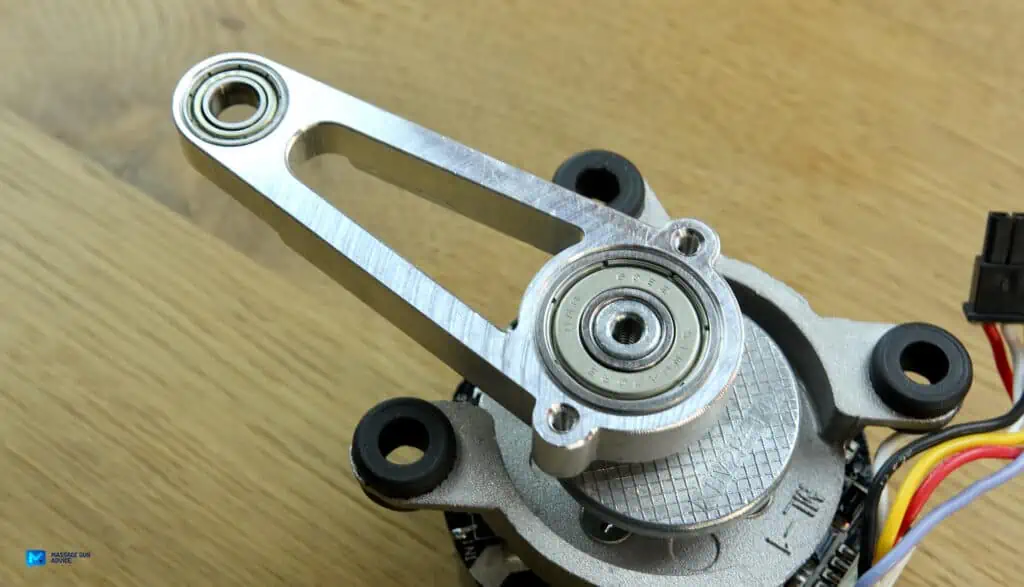
The beauty of this mechanism lies in its simplicity and effectiveness. It’s a delicate dance of physics and engineering.
Brands that excel invest heavily in research and development to balance ERM size, amplitude, and motor speed, ensuring their massage guns deliver effective deep tissue therapy without overburdening the motor.
This intricate balancing act is why there’s no one-size-fits-all ‘best’ model. It’s about finding the right harmony for each device’s intended use.
Author’s Note: The percussive mechanism in massage guns, using an Eccentric Rotating Mass (ERM), transforms motor rotation into linear massage motions. The ERM’s size affects amplitude and speed, requiring a careful balance with motor RPM for effective, deep tissue massage without straining the motor.
Massage Gun Head – The Personal Touch of Relief
The massage gun head is where the device truly connects with you, offering tailored relief and comfort. These interchangeable heads are designed for various massage types and targeting specific body areas.
TIP For the curious, explore our guide on massage gun heads, their types, materials, and builds. For advice on selecting and using attachments for specific body areas, refer to this focused article.
Here, we explore the attachment mechanisms that bring this personalized touch:
Push-and-Pull Mechanism (Push-In or Friction Fit)
This common method involves a stem on the head that snugly fits into the gun’s receptacle, often reinforced with rubber gaskets or O-rings for friction.
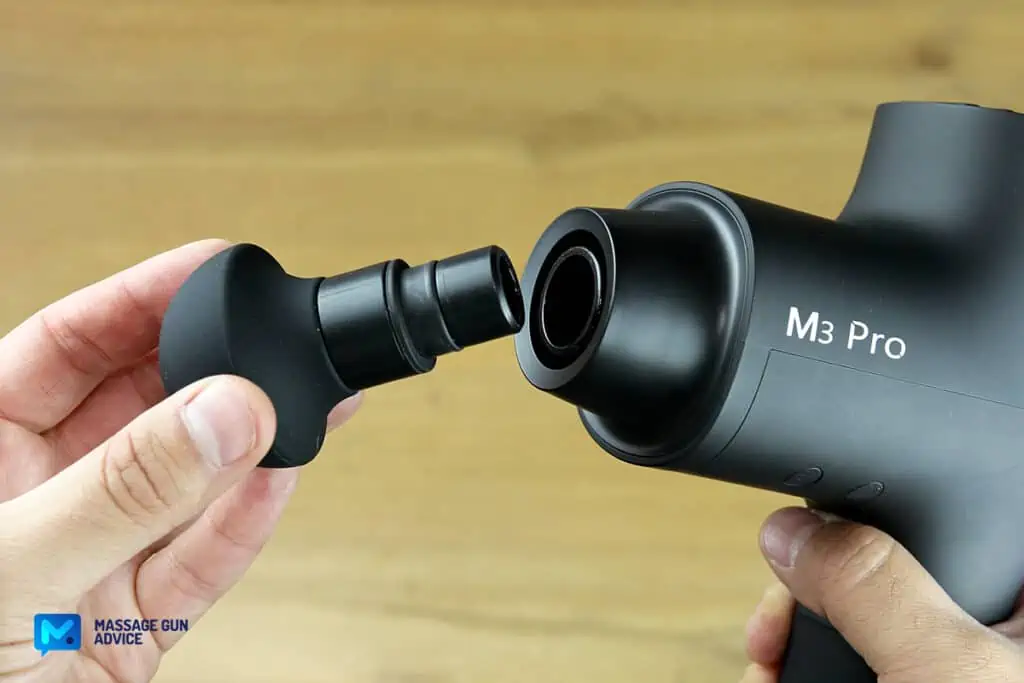
Pros:
- Ease of Use: Changing heads is straightforward and quick, ideal for those who need to switch between heads frequently.
- Reliability: With fewer parts involved, there’s less likelihood of mechanical failure, enhancing the device’s overall reliability.
- Cost-Effectiveness: The simplicity of this design translates to lower manufacturing costs, often making these models more affordable.
- Wide Availability of Replacements: Due to its commonality, finding replacement heads is usually easy, with many options available online.
Cons:
- Potential for Heads to Dislodge: In some cases, especially if the fit isn’t tight, the head might come off during use.
- Wear over Time: Repeated use can lead to a looser fit, potentially requiring replacement of the gasket to maintain a snug fit.
Examples: This method is popular among a variety of brands, particularly in more budget-friendly models, like the Opove or Achedaway.
Some manufacturers mix it up. Case in point, Ekrin employs it in Bantam and B37 but use Push and Twist in B37S and 365.
Push and Twist Locking System (Threaded or Screw-In)
This is less common. It involves a threaded stem on the head that screws into the gun.
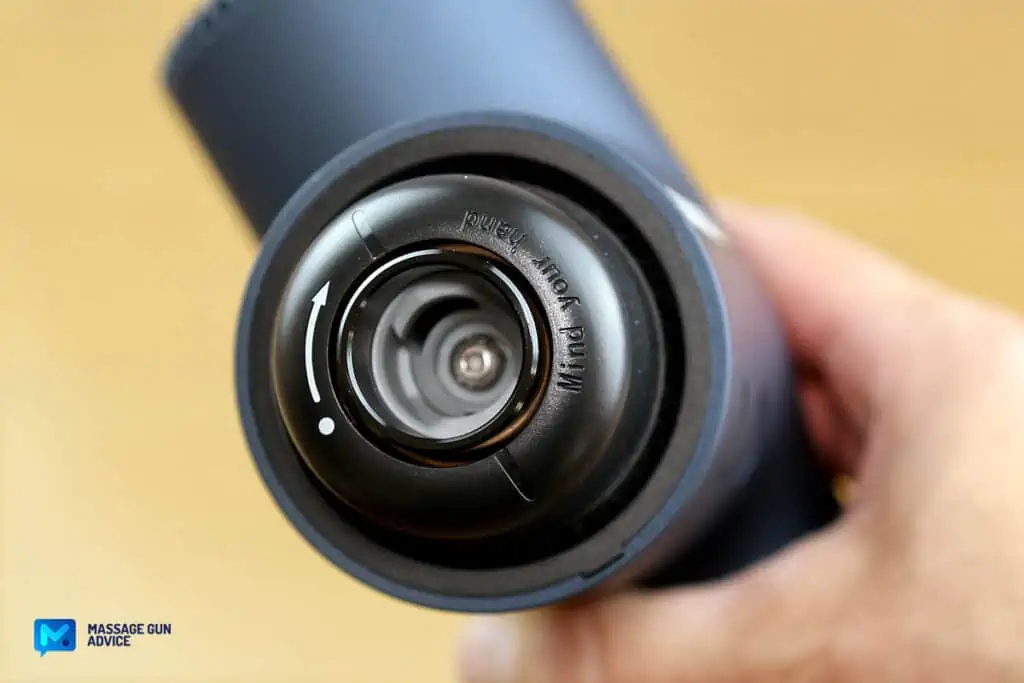
Pros:
- Secure Fit: This mechanism significantly reduces the risk of the head becoming loose or detaching during use.
- Durability: The threaded design tends to withstand wear and tear better, maintaining a secure fit over a longer period.
Cons:
- More Time-Consuming Head Changes: Swapping heads takes slightly more time and effort compared to the push-and-pull method.
- Risk of Cross-Threading: Incorrect alignment can damage the threads, making it difficult to attach or remove heads.
- Higher Manufacturing Cost: The complexity of this design typically results in higher production costs.
Theragun’s Unique System
Theragun uses its own system, praised for ease of use, interchangeability across all Theragun models, and a secure fit on the stem.
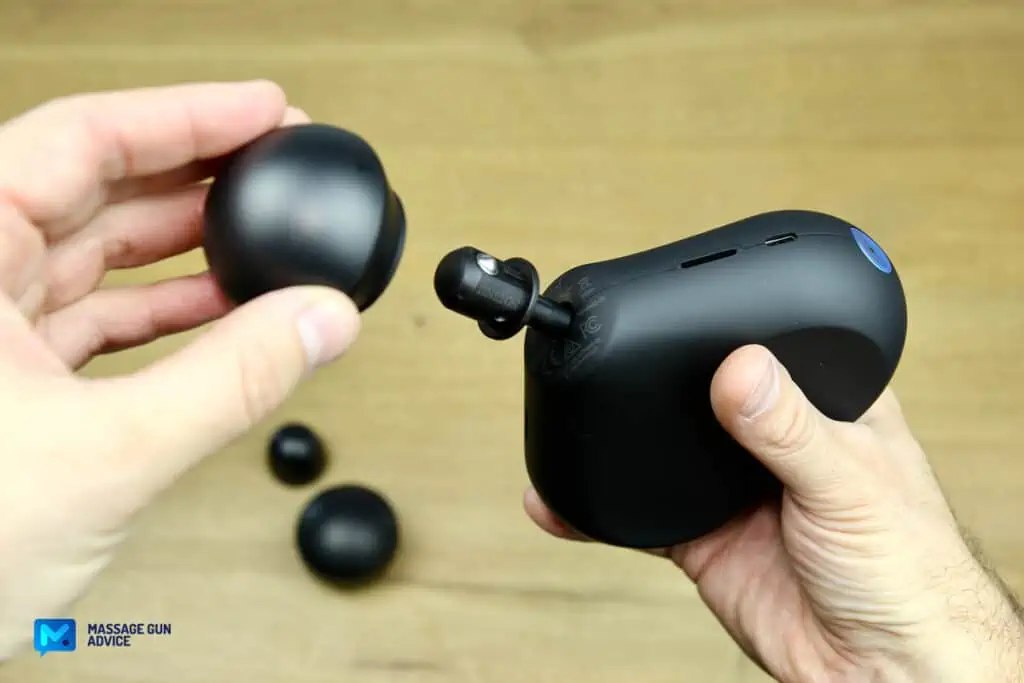
Pros:
- User-Friendly Design: Known for its simplicity, making changing heads effortless.
- Interchangeability across Models: All Theragun models use the same system, allowing for versatile use of attachments.
- Stable and Secure Fit: Ensures that the head stays firmly in place during use.
Cons:
- Brand Specificity: Being unique to Theragun, it limits interchangeability with heads from other brands.
Examples: Exclusive to Theragun models, recognized for their ease of use and consistent performance.
Each mechanism has its pros and cons, but they all converge on one goal: to provide a customizable and effective massage experience. The choice of the attachment mechanism is a critical factor in the overall performance and user satisfaction, influencing not just the massage quality but also the ease and convenience of use.
This is why brands investing in innovative designs and reliable systems often lead the market, ensuring their devices offer both versatility and enduring performance.
Battery – The Essential Power Source of Massage Guns
Massage guns typically harness the power of Lithium-Ion (Li-ion) batteries, celebrated for their high energy density. This means they pack a substantial energy punch in a compact form, perfect for portable devices like massage guns.
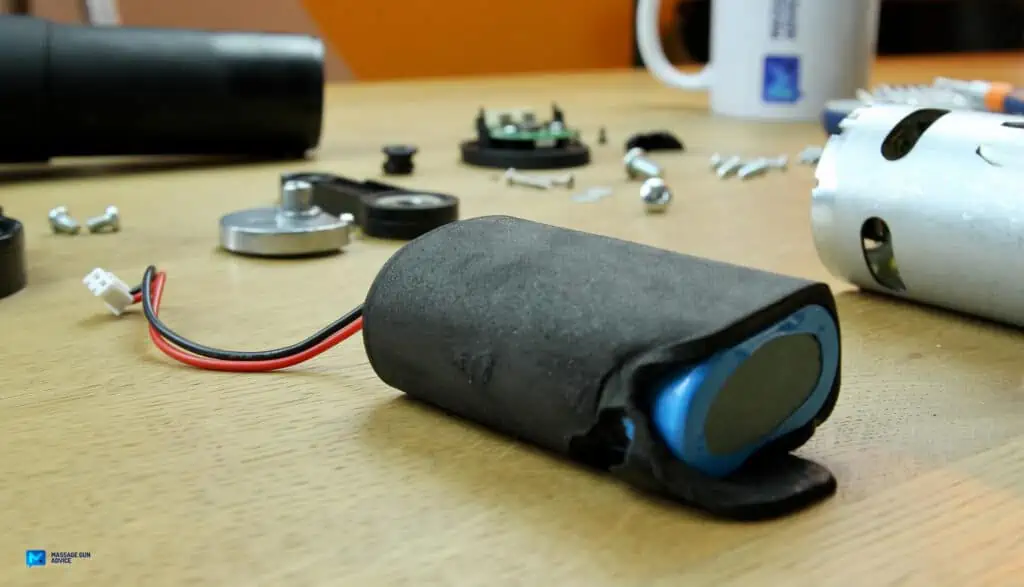
Let’s break down the battery build options:
Built-in Batteries
Pros: These batteries contribute to a sleeker design, can be lighter, and often offer enhanced protection for the battery itself.
Cons: The downside is that if the battery fails or wears out, you might be looking at servicing or replacing the entire device.
Removable Batteries
Pros: The advantage here is the ease of replacement. You can also carry spare batteries, extending the usage time significantly.
Cons: However, this can lead to a bulkier design and requires extra attention in handling and storing the additional batteries.
Examples: Models like Achedaway Pro, Theragun Pro 4th and 5th Gen, Hypervolt 2 Pro, and Lifepro Sonic use removable batteries.
Regarding battery life, it varies based on the battery’s capacity (mAh) and how intensely the gun is used. Our tests show that on average, massage guns offer between 2 to 6 hours of use on a single charge. The charging time ranges from 1 to 3 hours, depending on the charger’s output and the battery’s capacity.
Personally, we lean towards built-in batteries, as they often lead to better ergonomic designs. Most massage guns with removable batteries stick to the standard T-Shape, which isn’t always the best for grip. However, there are well-designed exceptions like the Achedaway Pro with its slightly angled handle and the Theragun Pro, where the battery is integrated into one of the triangle-shaped grips.
The control panel on a massage gun is your interface with the device, dictating how you interact with its various functions. Let’s delve into the different types of control panels:
Single-Button Control Panels
It’s one button that does it all. Simple, easy to use, and less troublesome if it breaks. Usually, it’s a long press to turn the device on, then a click to cycle through the speeds, and a long press again to turn it off.
Examples: Common in mini massage guns (like the Theragun Mini or Bob and Brad Air 2 Mini), as well as in full-sized models like those from Ekrin, this design features a single button for both power and speed adjustments.
Pros: This setup is appreciated for its simplicity, especially in devices with up to 5 speed settings.
Cons: However, with more than 5 speeds, cycling through all the options with one button can become tedious, particularly in models with an extensive range of speeds.
Separate Speed Controls (+/- Buttons)
Sometimes there are + and – buttons; other times, ↑ (Up) and ↓(Down) arrows, but the idea is the same: you have two buttons to control the speed in both directions.
Examples: Full-sized Theraguns and the Bob and Brad D6 Pro are good examples of this.
Pros: These designs allow for more precise and user-friendly speed adjustments, enabling users to easily increase or decrease intensity. We find this type of control to be the most preferable. It offers the best user experience we’ve seen so far, combining simplicity with efficiency.
Cons: None.
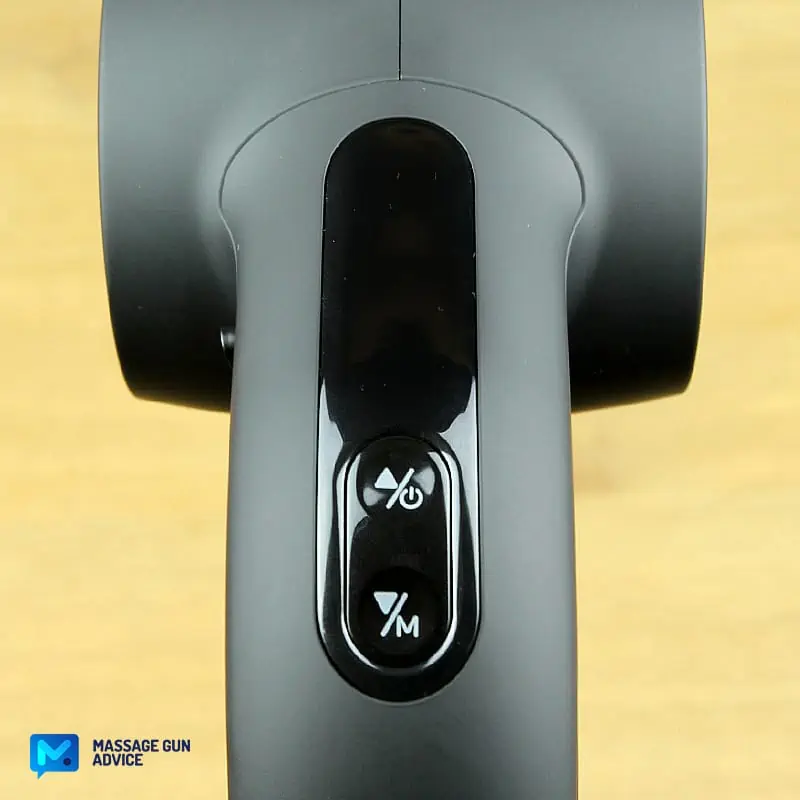
Complex Control Panels with Displays
These panels include LED or OLED displays and indicators for additional functions like pressure sensors.
While they offer more information and control, finding a balance between functionality and usability can be challenging, especially in less expensive models.
Honestly, we haven’t seen any such solution executed well. We favor simplicity.
Examples: Zarifa Z-Smart Health+ (on picture).
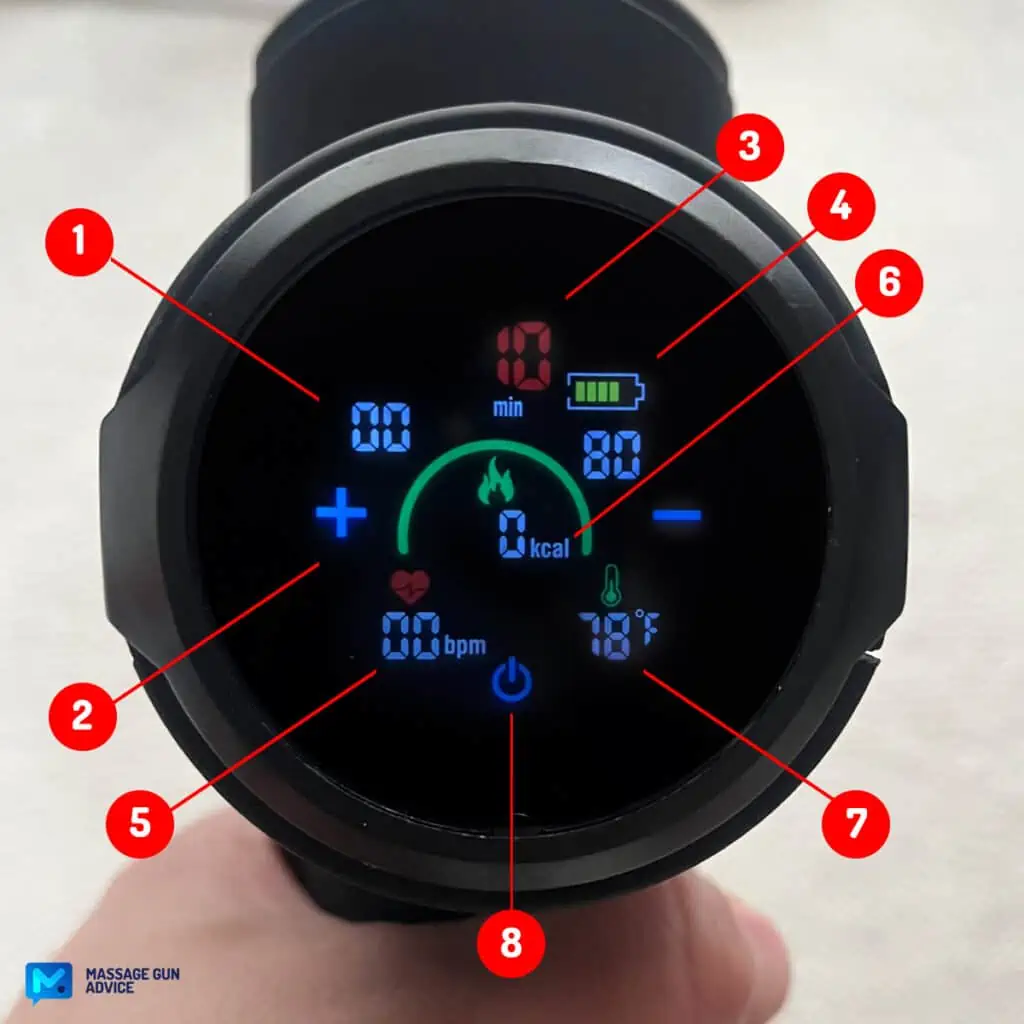
Innovative Designs
We often see innovative features in control design, but they seldom work well in daily use.
Take touch buttons, for instance. They look sleek and modern, but they’re more hassle than helpful. The reason? When using a massage gun, your hands often sweat, making these buttons less effective and dirty.
Example: A standout innovation we’ve seen is Hypervolt’s dial in the Hypervolt 2 Pro. It’s manual, practical, and intuitive – a quick solution that we really appreciate.
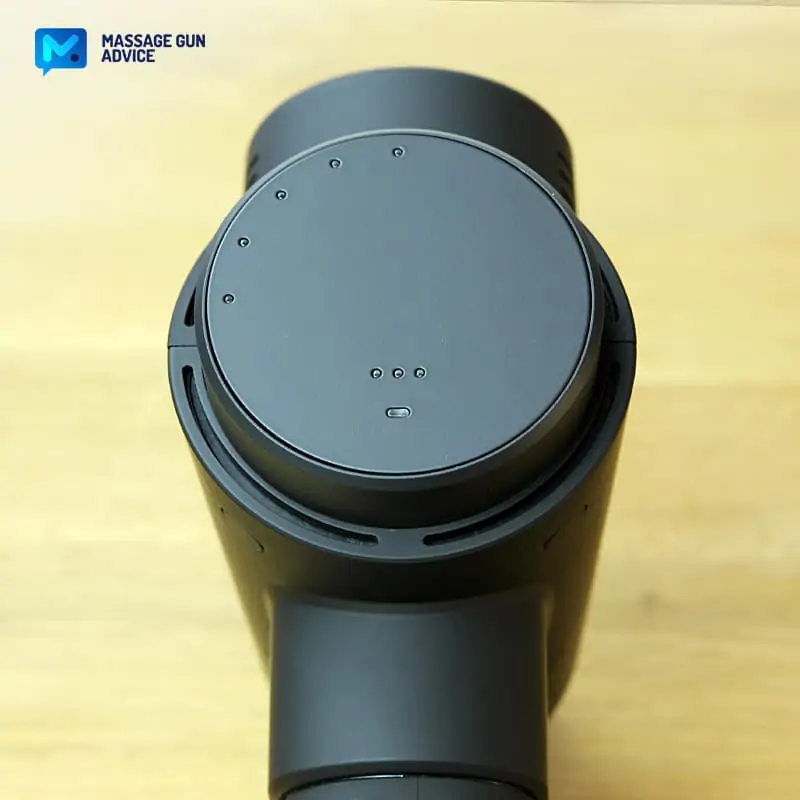
In the realm of massage gun control panels, large players like Theragun or Bob and Brad excel, offering refined ergonomics that seamlessly blend functionality with ease of use.
The design of the control panel is a critical aspect of the user experience, impacting not only how you interact with the device but also how effectively you can customize your massage experience.
As technology evolves, we’re seeing more innovative and intuitive solutions that cater to a wide range of user preferences and needs.
Housing – The Intersection of Style, Comfort, and Durability in Massage Guns
The housing of a massage gun is more than just its outer shell; it’s a fusion of form and function that significantly shapes your experience with the device.
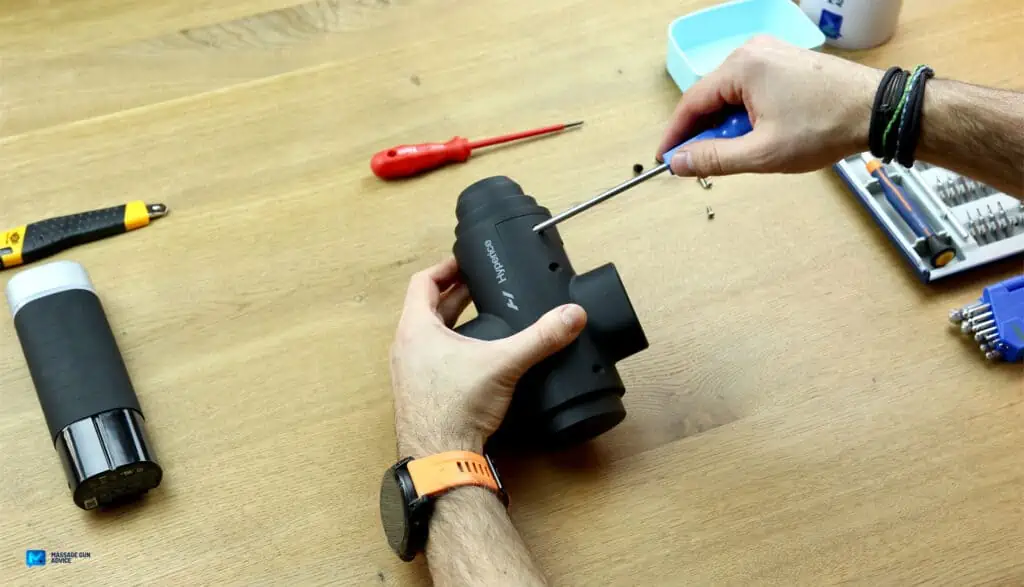
Aesthetics and Material Quality
Importance: The housing isn’t just about looks; it’s about feeling the quality in your hands. The choice of materials is pivotal for that premium sensation – it’s what separates top-tier brands like Theragun from more budget-friendly options found on Walmart or Amazon shelves. High-quality materials not only enhance the visual appeal but also contribute to the product’s durability and value.
Ergonomics
Why It Matters: A well-designed housing is key to user comfort. It should fit naturally in your hand, minimizing strain during use. Top brands like Theragun, Bob and Brad, and Ekrin excel in this domain. Their products are examples of ergonomic brilliance, designed with user comfort at the forefront, allowing for effortless operation even during extended massage sessions.
Heat Dissipation
Critical for Performance: In more powerful models, efficient heat management is vital. A smartly designed housing will incorporate features like air vents for passive cooling. This not only extends the life of the device but also ensures safety during use.
Conclusion
We’ve delved into the massage guns construction, from motor details to housing design. I tried to be detailed and technical, but at the same time, I didn’t want to overdo it with the engineering stuff so that it stays readable for the average person. I hope I managed to do that.
If you have questions or need more insights, feel free to comment or connect with us on our social media channels, or in our Facebook Group: Massage Gun Talks.
Sources
Was this article helpful?
Post Update History
Here's a quick rundown of all the tweaks and edits we've made to this article to keep it accurate and up-to-date!
Current version.
Published on:
•
Written by:

Luke Deszczulka
Leave a Reply
Disclaimers
The views and opinions expressed on this website are those of the authors. Any content provided by our bloggers or authors is of their opinion and is not intended to malign any religion, ethnic group, club, organization, company, individual, or anyone or anything.
All product names, logos, and brands are the property of their respective owners. All company, product, and service names used on this website are for identification purposes only. Use of these names, logos, and brands does not imply endorsement.
Our policy is to make every effort to respect the copyrights of outside parties. If you believe your copyright has been misused, please provide us with a message stating your position, and we will endeavor to correct any misuse immediately.
Some of the links in this post may be affiliate links. If you click on the link and purchase the item, we may receive an affiliate commission at no extra cost to you. Learn more here.
